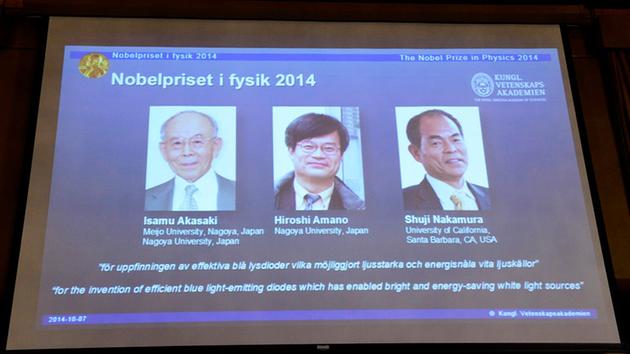一
名美國科學家和兩名日本科學家因發明新的節能環保光源獲得諾貝爾物理學獎,該光源為LED燈的問世鋪平了道路。The blue light-emitting diode, which won the Nobel Prize in Physics for Japanese scientists Isamu Akasaki, Hiroshi Amano and Shuji Nakamura.

Agence France-Presse/Getty Images
中村修二,照片攝於2004年1月30日。
NOBEL PRIZE WINNERS IN PHYSICS


STOCKHOLM --
A University of California, Santa Barbara professor was among the three Nobel Prize winners in physics for inventing the blue light-emitting diodes, a breakthrough that has spurred the development of LED technology to light up homes, computer screens and smartphones worldwide.Isamu Akasaki, Hiroshi Amano and naturalized U.S. citizen Shuji Nakamura revolutionized lighting technology two decades ago when they came up with a long-elusive component of the white LED lights that in countless applications today have replaced less efficient incandescent and fluorescent lights.
"They succeeded where everyone else had failed," the Nobel committee said. "Incandescent light bulbs lit the 20th century; the 21st century will be lit by LED lamps."
Red and green light-emitting diodes have been around since the mid-20th century and have been used in applications such as watches and calculators. But scientists had struggled for decades to produce the shorter-wavelength blue LED needed in combination with the others to produce white light when the three laureates made their breakthroughs in the early 1990s.
Their work enabled LED lights - more efficient and long-lasting than previous light sources - to be used in a range of applications, including street lights, televisions and computers.
"It is very satisfying to see that my dream of LED lighting has become a reality," Nakamura, 60, said in a statement released by the University of California, Santa Barbara, where he is a professor.
"I hope that energy-efficient LED light bulbs will help reduce energy use and lower the cost of lighting worldwide," he said.
Akasaki, an 85-year-old professor at Meijo University and Nagoya University, said in a nationally-televised news conference in Japan that he had often been told that his research wouldn't bear fruit.
"But I never felt that way," he said. "I was just doing what I wanted to do."
Akasaki and Amano, 54, made their inventions while working at Nagoya University while Nakamura was working separately at Japanese company Nichia Chemicals. They built their own equipment and carried out thousands of experiments - many of which failed - before they made their breakthroughs.
The Nobel committee said LEDs contribute to saving the Earth's resources because about one-fourth of world electricity consumption is used for lighting purposes. They tend to last 10 times longer than fluorescent lamps and 100 times longer than incandescent light bulbs.
"The blue LED is a fundamental invention that is rapidly changing the way we bring light to every corner of the home, the street and the workplace - a practical invention that comes from a fundamental understanding of physics in the solid state," said H. Frederick Dylla, the executive director and CEO of the American Institute of Physics.
Phillip Schewe, a physicist at the Joint Quantum Institute at the University of Maryland, said the prize shows that physics research can provide a practical benefit, rather than just probing the mysteries of the universe.
LED technology holds particular promise in lighting up parts of the developing world with poor electricity grids, Nobel committee member Olga Botner said. Ultraviolet LEDs can also be used to sterilize water, she said.
"It is not just for lighting Christmas lights on the streets of Stockholm in December but really something that benefits mankind, particularly the Third World," she said.
Nadarajah Narendran, director of research at the Lighting Research Center at the Rensselaer Polytechnic Institute in Troy, New York, estimated that about 10 percent of illumination in U.S. homes, offices, streets and industries comes from LED lights. Within five years, he said, that fraction will probably exceed 30 percent as prices come down.
On Monday, U.S.-British scientist John O'Keefe split the Nobel Prize in medicine with Norwegian couple May-Britt Moser and Edvard Moser for breakthroughs in brain cell research that could pave the way for a better understanding of diseases like Alzheimer's.
The Nobel award in chemistry will be announced Wednesday, followed by the literature award on Thursday, the Nobel Peace Prize on Friday and the economics prize on Monday.
Worth 8 million kronor ($1.1 million) each, the Nobel Prizes are always handed out on Dec. 10, the anniversary of prize founder Alfred Nobel's death in 1896. Besides the prize money, each laureate receives a diploma and a gold medal.
Nobel, a wealthy Swedish industrialist who invented dynamite, provided few directions for how to select winners, except that the prize committees should reward those who "have conferred the greatest benefit to mankind."
Last year's physics award went to British scientist Peter Higgs and Belgian colleague Francois Englert for helping to explain how matter formed after the Big Bang.
___
Associated Press reporter Yuri Kageyama in Tokyo, and Malcolm Ritter in New York, contributed to this report.
瑞典皇家科學院(Royal Swedish Academy of Sciences)在一份聲明中表示,當這三位科學家在上世紀90年代初從半導體中生成亮藍色的光束時,他們引發了照明技術的根本轉變。
赤崎勇和天野浩均是日本名古屋大學(Nagoya University)的教授。赤崎勇同時還供職于名古屋市的名城大學(Meijo University)。中村修二則是加州大學聖巴巴拉分校(University of California, Santa Barbara)的教授。
諾貝爾物理學獎被認為是物理學領域最知名的獎項,獲獎者可得到800萬瑞典克朗(合110萬美元)獎金。在全球數千名科學家受邀提名候選人之后,獲獎者由瑞典皇家科學院確定。
Anna Molin

沒有留言:
張貼留言